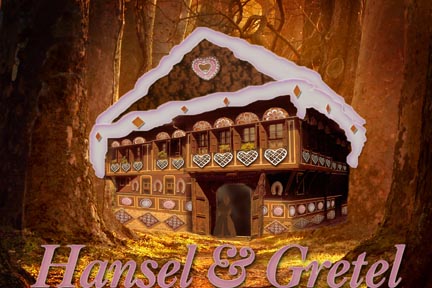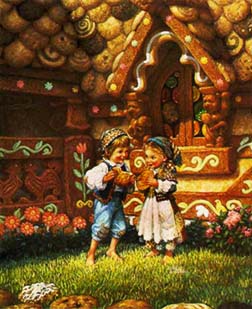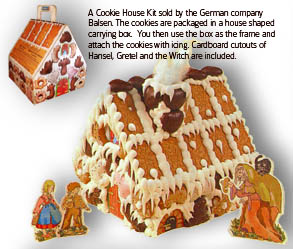
About the Hansel and Gretel Story
by Phyllis Wetherill
The children’s story which dominates the German kitchen is Hansel and Gretel, collected by the Brothers Grimm from story tellers and published in written form about 1832. This story has undergone two major changes of interest to cookie bakers: the embellishment of the witch’s house, and the addition of a fence around the house made of gingerbread boys and girls. One version states that the witch turned into a large gingerbread cookie in the oven.
 The early English translations of this Grimm fairy tale describe the witch’s house as “built entirely of bread, ornamented with cake, and . . . its windows were of clear sugar.” By contrast, an English translation of the story published in 1971 in Czechoslovakia, describes the house as “all made of gingerbread and pastry.” Furthermore, it says that “in the idle [of the cottage] was a fireplace made of pastry.” The illustrations show cookies everywhere, as pendulums for the clock, as fruit on the trees, as the tiles in the floor, and as the roof of the stall in which Hansel was confined. The early English translations of this Grimm fairy tale describe the witch’s house as “built entirely of bread, ornamented with cake, and . . . its windows were of clear sugar.” By contrast, an English translation of the story published in 1971 in Czechoslovakia, describes the house as “all made of gingerbread and pastry.” Furthermore, it says that “in the idle [of the cottage] was a fireplace made of pastry.” The illustrations show cookies everywhere, as pendulums for the clock, as fruit on the trees, as the tiles in the floor, and as the roof of the stall in which Hansel was confined.
When Engelbert Humperdinck wrote the opera Hansel and Gretel, his sister, Frau Adelheid Wette, wrote the libretto. She added to it the idea of a fence made of previously captured children who were turned to gingerbread. When the witch was killed, the gingerbread children were restored to life and could return to their families. The theatric value of this change is obvious; some Hansel and Gretel stories keep this variation.
 Exactly why the gingerbread house is so popular in Germany at Christmas is not known. Every bakery window offers a village of houses for sale. Most have Hansel, Gretel and the witch standing somewhere in the yard. None of the German houses, even the ones produced by the German Bahlsen company for assembly, parallel the ornateness of many of the gingerbread houses described in magazines in the United States. Exactly why the gingerbread house is so popular in Germany at Christmas is not known. Every bakery window offers a village of houses for sale. Most have Hansel, Gretel and the witch standing somewhere in the yard. None of the German houses, even the ones produced by the German Bahlsen company for assembly, parallel the ornateness of many of the gingerbread houses described in magazines in the United States.
The first cutters made by the Educational Products Company were of Hansel, Gretel, the witch, the gingerbread house and a tree. The set, made in 1947, was featured in the Women’s Home Companion in 1948. Other companies have made boy and girl cutters which adapt themselves to being used as Hansel and Gretel. A rather shapeless cutter made in Germany makes Hansel and Gretel cookies when colorful, preprinted pictures are glued in the cookies with frosting.
 Gingerbread houses can be made in many ways. A gingerbread house cake mold can be purchased in the United States. A gingerbread house cake mold made in Germany makes not only the house, but it molds a boy and girl at the front of the house and the witch at the back of the house. Some gingerbread houses are made from sheets of gingerbread; others are made by applying frosting and cookies to cardboard houses. Cookies or candy decorating the house need not be of any particular shape, although one often finds a liberal number of heart shapes on most gingerbread houses. Gingerbread houses can be made in many ways. A gingerbread house cake mold can be purchased in the United States. A gingerbread house cake mold made in Germany makes not only the house, but it molds a boy and girl at the front of the house and the witch at the back of the house. Some gingerbread houses are made from sheets of gingerbread; others are made by applying frosting and cookies to cardboard houses. Cookies or candy decorating the house need not be of any particular shape, although one often finds a liberal number of heart shapes on most gingerbread houses. |
|

